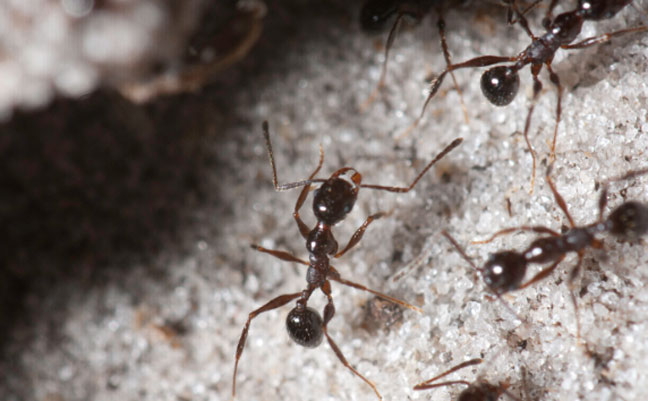
Big-headed ant populations can be treated with an appropriate mix of liquid and granular baits and liquid and dust insecticides, depending on colony locations. Photo: ©Gene White
Many ant experts agree that this genus is one of the most abundant and diverse groups of ants in the world. More than 1,000 species have been identified, and it is assumed that more species are yet to be officially discovered.
In the U.S., where there are approximately 74 species, big-headed ants are found mostly in the warm and dry regions of the South, particularly the Southwest. Nests are found in exposed soil or under cover, and in rotting wood. They rarely nest indoors but may invade homes to forage for food. They prefer meats, grease and breads. These reddish-brown ants are considered scavengers and feed on insects, seeds and honeydew. They can be distinguished from similar-looking species by the presence of 12 segments in their antennae, with three-segmented antennal clubs.
Most Pheidole species’ worker castes are dimorphic, which means they are two different sizes. A few species are trimorphic, which means they have a supermajor worker caste that can measure up to 0.31 inch (8 millimeters).
Big-headed ant soldiers, measuring 0.08 to 0.20 inch (2 millimeters to 5 millimeters), are major workers that serve strictly a defensive function. They have exceptionally large heads in relation to their body size, hence the common name. By contrast, the scientific name originates from the Greek pheid, which means “sparing” or “thrifty” and likely refers to their penchant for seed-storing. Despite looking fierce, they tend to flee at the first sign of danger.
Big-headed ant minor workers, measuring 0.06 to 0.16 inch (1.5 millimeters to 4 millimeters), have a slender body shape and do not have enlarged heads. They can be recognized by the shape of their heads, which narrow abruptly behind the eyes.
To form new colonies, mating flights typically form in the summer. Multiple queens may form a new colony, but in most cases, one queen eventually dominates, killing the other queens.
REFERENCES
- BugGuide.net/node/view/49416, accessed Jan. 24, 2023
- UrbanEntomology.tamu.edu/urban-pests/ants/big_headed, accessed Jan. 24, 2023
- Truman’s Scientific Guide to Pest Management Operations, Seventh Edition, available for purchase at MyPMP.net/shop
Leave A Comment